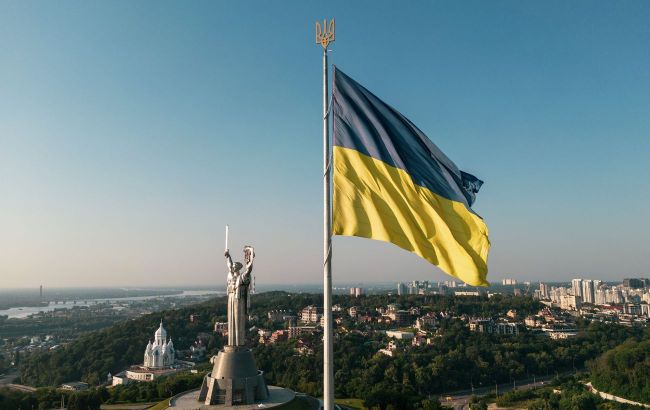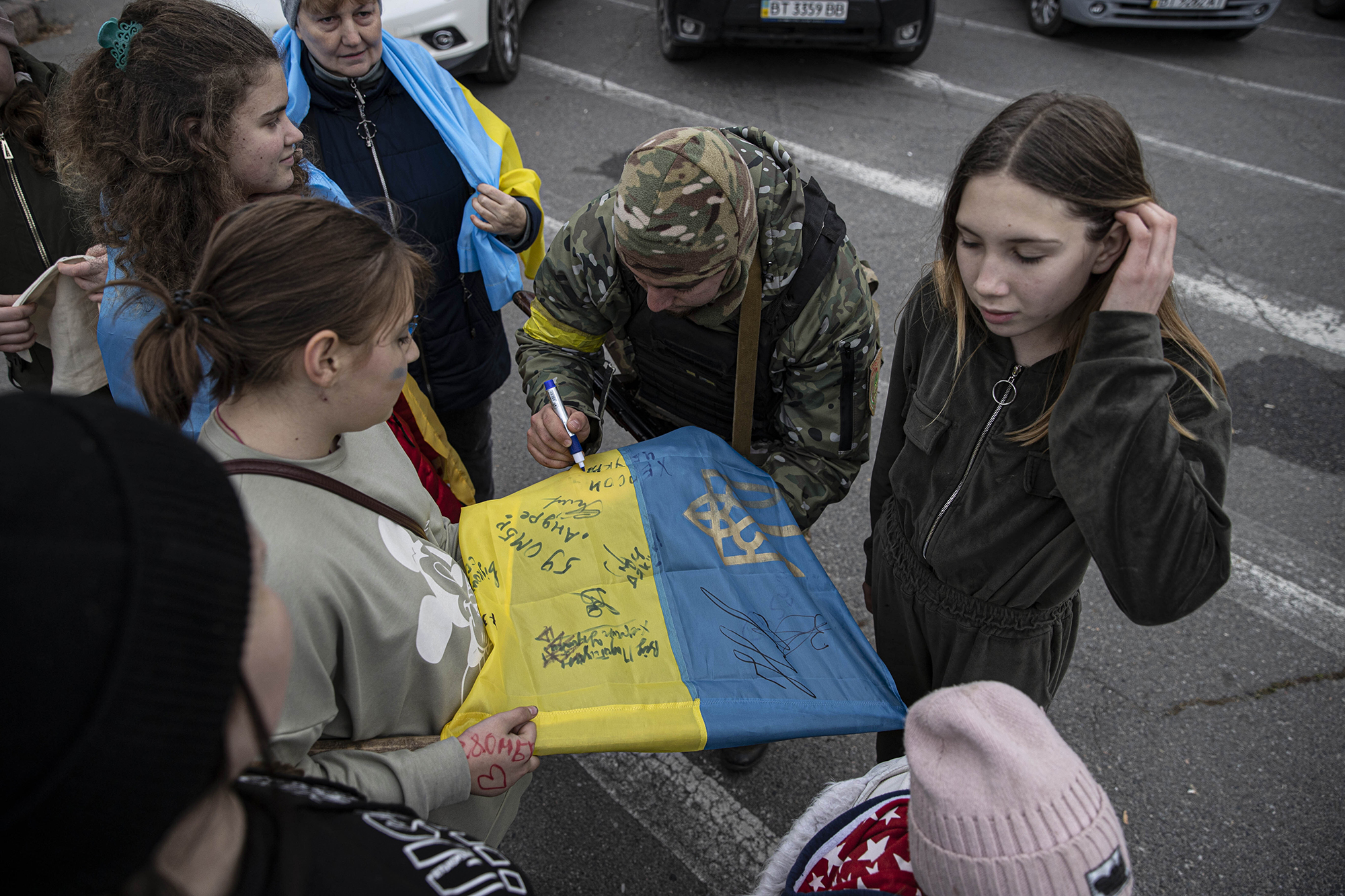Ukraine’s National Flag Day: How blue and yellow flag became symbol of struggle for freedom
 Photo: August 23 is Flag Day in Ukraine (Getty Images)
Photo: August 23 is Flag Day in Ukraine (Getty Images)
On August 23, Ukraine celebrates National Flag Day. Despite all prohibitions, the main national symbol has accompanied Ukrainians on their path to independence. Today, the blue and yellow flag embodies the struggle for freedom—on the chevrons of soldiers, safely hidden in occupied territories and raised over liberated cities.
More about the history of the national flag and its significance during the war can be found in the material by RBC-Ukraine.
Contents:
-
When the Ukrainian flag appeared and why it's blue and yellow
-
National symbol under prohibition
When the Ukrainian flag appeared and why it's blue and yellow
In 1992, the Verkhovna Rada of Ukraine approved the national flag as a rectangular canvas consisting of two stripes: the upper one is blue, and the lower one is yellow. However, the national symbol in this form has been used for a long time.
The blue and yellow flag was the official banner of Ukrainians during the national liberation movement in the early 20th century (UPR, WUNR, Hetmanate). In 1918, it accompanied the soldiers of the Ukrainian National Republic Army, the Ukrainian Galician Army, and the UPR Black Sea Fleet ships. In 1939, the blue and yellow flag was also the banner of Carpathian Ukraine.

Photo: flag of the UPR Minister of Maritime Affairs (wikimedia.org)
The Ukrainian flag first appeared over the Lviv Town Hall in 1848. During the national revival in Galicia (the "Spring of Nations"), the Main Ruthenian Council adopted the national symbol.
The symbol was based on the medieval coat of arms of the Galicia-Volhynia Principality—a golden lion on a blue background. However, due to the complexity of making the ornament, simpler flags with two sewn horizontal stripes of blue and yellow fabrics became more widespread.
The sequence of colors was long debated, as some historical sources mention a yellow-blue flag instead of a blue-yellow one.
In photos from the early 20th century, the upper part of the canvas also appears lighter, but this was due to the photographic technology of the time (when developing film, dark areas appeared light).

Photo: Ukrainian Galician Army soldiers with a flag. The colors are distorted due to the peculiarities of photo development (wikimedia.org)
Official confirmation of the blue-yellow sequence can be found in the 1918 decree on the Ukrainian naval flag of the UPR.
The interpretation of the colors also favors the blue-yellow order: blue symbolizes the sky, and yellow represents the golden fields of wheat.
National symbol under prohibition
After the Soviet regime was established in Ukraine, the national flag was banned. Using it could lead to imprisonment. The KGB closely monitored such "anti-Soviet" expressions, but this did not stop patriots.
Flags were displayed in many cities across the country:
- On May Day in 1966, the blue and yellow flag flew over the building of the Kyiv Institute of National Economy (now the Kyiv National Economic University).
For this "offense," Viktor Kuksa was sentenced to two years in prison, and his friend Heorhii Moskalenko was sent to a strict-regime camp for three years.
- On December 30, 1967, an unknown person hung a blue and yellow flag with the inscription "Ukraine has not yet perished, nor her glory and freedom" near the Dnipro district executive committee entrance.
- On May 9, 1968, Petro Krupnyk, convicted for connections with the OUN, hung the Ukrainian flag on the building of the village council in Kulykiv, Lviv region.
- On January 22, 1973, four blue and yellow flags were raised in Chortkiv, and proclamations were posted for the 55th anniversary of the Fourth Universal of the Central Rada proclamation.
- On February 21, 1976, the national flag was raised in Kyiv on the roof of building No. 21 on Khreshchatyk.
Despite the ban in the last year of the USSR's existence, the Ukrainian flag increasingly appeared on the streets of Drohobych, Lviv, Ivano-Frankivsk, Zhytomyr, and Kyiv.
In July 1991, the national flag flew over Sviatohirsk (Donetsk region) above the Siverskyi Donets. In Dnipro, the flag was installed near the Shevchenko Theater, and round-the-clock security was organized, but after a few weeks, the police dispersed the activists and destroyed the canvas.

Photo: Raising Ukrainian flag in Kyiv on July 24, 1990 (wikimedia. org)
- On January 22, 1990, the "Ukraine's Human Chain" from Ivano-Frankivsk to Kyiv occurred under blue and yellow flags.
- On July 24, 1990, on the occasion of the adoption of the Declaration of State Sovereignty of Ukraine, the blue and yellow flag was raised over the building of the Kyiv City Council, where a mass rally was held.
- On August 23, 1991, the blue and yellow canvas was brought into the building of the Verkhovna Rada. The next day, Ukraine declared its independence, and the flag was draped over the parliamentary tribune.
It was in honor of the events of August 23 that the holiday of National Flag Day was established.
Ukrainian flag in war
After the Russian invasion of Ukraine, the national flag gained special significance. On combat positions, military vehicles, and armor, it symbolizes the fight for the country’s freedom.
In 2014, during the defense of Donetsk airport, Ukrainian "cyborgs" repeatedly raised the flag over buildings. The Ukrainian flag was the first to return to liberated territories during the ATO/JFO and the full-scale war.
During the counteroffensive in Kharkiv region in 2022, the Armed Forces of Ukraine returned the flag to hundreds of settlements, and sometimes residents did so.
For example, in Kozacha Lopan, after the de-occupation, the village headman rode a bicycle to hang the Ukrainian flag near the village council building before the military arrived.
In Tsyrkuny, people rejoiced at the sight of the blue and yellow flag because its appearance meant that they could finally go outside without fear. "There was so much joy! A neighbor said: 'Let’s go to the club, there’s a flag hanging there,'" a resident of Tsyrkuny told Suspilne.
In the village of Rubizhne, Vovchansk district, Kharkiv region, the military arrived at night, and in the morning, they hung an ironed flag over the village council. During the occupation, local residents repeatedly tore down the Russian tricolor from the building, forcing the occupiers to install traps.
Ukrainians risked their lives when they gathered with flags at rallies in captured cities or simply kept them at home.
Protests with Ukrainian flags took place in occupied Kupyansk, Starobilsk, Enerhodar, Melitopol, Berdiansk, Kakhovka, and other cities.
For more than a month, people held rallies in occupied Kherson despite the fact that the Russians brutally dispersed them with gunfire. After liberation, Kherson residents greeted the Ukrainian Armed Forces with flags they had hidden from searches.
"I put it in a robe, in a bag, and then under the refrigerator somewhere in the basement," a Kherson resident said about how she kept the flag.

Photo: Kherson after de-occupation (Getty Images)
In the Kharkiv region, a Ukrainian hid a flag in a jar and buried it in his garden. After the village was liberated, he asked the territorial defense soldiers to dig it up. The soldiers completed the task and signed the flag before returning it to its owner.

Photo: flag hidden by a resident of Kharkiv region (instagram.com/oborona.lviv)
In Kherson, a woman hid the Ukrainian flag in her yard under paving slabs.
Last year, on August 23, a special flag at military positions along the entire frontline was raised over Kyiv.
The canvas, signed by defenders, was raised near the Motherland Monument, and later, it became part of the exposition of the National Museum of the History of Ukraine in World War II.
Sources: materials from the Ukrainian Institute of National Memory, "Suspilne. Kharkiv," the portal 100krokiv.info, videos from the Ukrainian Witness YouTube channel, and information from Wikipedia.

